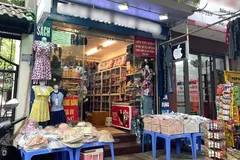
In recent years, Vietnamese banks have been working to improve this ratio, but in comparison to international standards, they still have a long way to go. While banking systems in many other countries are advancing towards Basel IV, Vietnamese banks are grappling with Basel II.
The Struggle with Basel II
For years, increasing charter capital has been a central focus for commercial banks. Government Decree 141/2006 mandates that the legal capital of banks in Vietnam must be VND 3,000 billion. However, State Bank Circular 41/2016 requires banks to meet Basel II standards and maintain a CAR of 8%. State Bank Circular 13/2018 further stipulates that banks must adhere to regulations on internal control systems, including risk management and capital resilience in adverse scenarios to fulfill all three pillars of Basel II.
Dr. Nguyễn Trí Hiếu, a banking finance expert, has noted that in the years between 2006 and 2010, some banks resorted to financial engineering to artificially inflate their capital in compliance with Decree 141/2006. Later, to meet Basel standards according to Circular 41/2016 and Circular 13/2018, some banks found ways to circumvent the issuance and cross-investment of bonds to boost tier 2 capital. Recognizing the challenges faced by banks, the State Bank of Vietnam (SBV) extended the deadline until December 1, 2023, for banks that failed to meet the CAR ratio requirements according to Circular 41/2016. As a result, two groups of banks emerged within the banking system, one adhering to Circular 41/2016 (Basel II standards) and another following Circular 22/2019.
These differences, combined with the unique operational characteristics of each bank, have resulted in significant disparities in CAR ratios between the two groups. State Bank data reveals that, by the end of August, the group of banks complying with Circular 41/2016 maintained an average CAR ratio of 11.58%. Within this group, banks with state capital achieved 9.64%, while joint-stock commercial banks reached 11.55%.
The leading CAR ratio in the banking industry currently stands at 15%, held by Techcombank. A few other banks also maintain CAR ratios exceeding 12%, including VPBank, HDBank, TPBank, ACB, VIB, and MB. However, joint-stock commercial banks adhering to Circular 22/2019 have a CAR rate of 9.18%.
Notably, the government's project, "Restructuring the System of Credit Institutions Associated with Bad Debt Handling in the 2021-2025 Period," has set an important goal of piloting the application of Basel II according to Advanced methods at state-owned commercial banks with controlling shares and joint-stock commercial banks exhibiting good governance quality. These banks are required to complete Basel II according to standard methods, aiming to achieve a minimum CAR ratio of 10-11% by 2023 and 11-12% by 2025. In comparison to these standards, domestic banks currently find themselves lacking in capital, necessitating a constant effort to fortify their CAR "buffer."
Thin Capital and the Perpetual Challenge of Bad Debt
The CAR coefficient at Vietnamese banks has improved significantly in recent years, but when compared to foreign banks, domestic banks still lag far behind. For instance, the CAR ratio according to Circular 41/2016 for foreign banks operating in Vietnam at the end of August was 20.81%, nearly double the average CAR ratio of domestic banks.
Vietnamese banks face not only pressure to meet international standards but also the need to increase capital to address the issue of bad debt. Data released by the State Bank indicates that the bad debt ratio increased from 2% at the beginning of the year to 3.56% by the end of July, amounting to over VND 440,000 billion. When considering bad debts on the balance sheet, unsold bad debts held by the Vietnam Asset Management Company (VAMC), and potential debt within the system, the bad debt ratio climbs to 6.16%, equivalent to VND 768,000 billion.
In the event of a significant increase in bad debts, banks that have made adequate provisions may face losses. These losses will reduce their equity and, consequently, their CAR ratio. Changes in the CAR ratio due to business activities are inversely related to a bank's capacity to extend credit. Banks with higher CAR ratios are granted greater credit limits by the State Bank, while other banks must raise capital to manage the associated risks. Faced with this pressure, many banks opt to pay dividends in shares to bolster their capital. A summary of the dividend plans of 28 banks revealed that charter capital is expected to increase by more than VND 163,000 billion in 2023, representing a 26.7% increase.
Furthermore, some banks are improving their CAR ratios by pursuing mergers and acquisitions (M&A). For example, VPBank sold 15% of its shares to Sumitomo Mitsui Banking Corporation (SMBC), a part of Japan's Sumitomo Mitsui Financial Group, Inc (SMFG), through private share issuance. LPBank intends to issue 300 million shares for private placement, SeABank plans to issue a maximum of 94.6 million additional shares, equivalent to 4.6366% for foreign investors, SHB is in negotiations to sell 20% of its shares to foreign investors, and Vietcombank is in the process of selecting foreign shareholders for a plan to privately issue 6.5% of charter capital, expected to occur in 2023-2024.
It is evident that efforts to raise capital and reinforce reserve buffers are a common challenge for Vietnamese banks. The pressure is especially prominent on small-scale joint-stock banks with low CAR ratios, particularly those following Circular 22/2019, as the extension period for implementing Circular 41/2016 will expire at the end of this year, coinciding with a challenging business environment.
Additionally, the four banks with state capital, including BIDV, Vietcombank, Agribank, and VietinBank, are under pressure, as each increase in capital requires government and National Assembly approval. Despite this, their CAR ratio is only slightly above the required level, which can affect their ability to provide credit and maintain a leading position in the credit institution system.
In sum, the challenge of raising capital to fortify reserve buffers is a common concern for Vietnamese banks. While they work towards Basel II compliance, they are also aware of the impending transition to Basel III, with the global banking sector already discussing Basel IV.




















